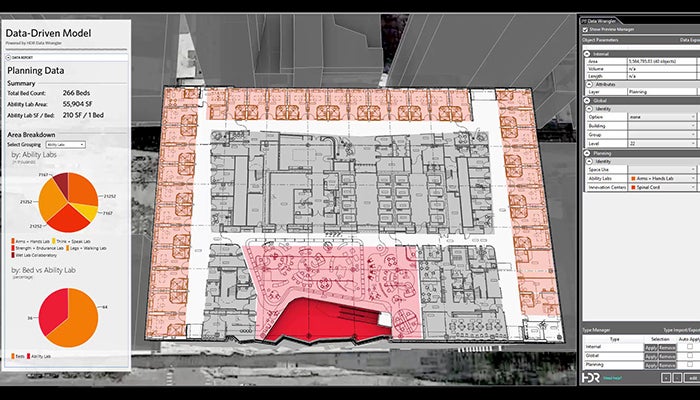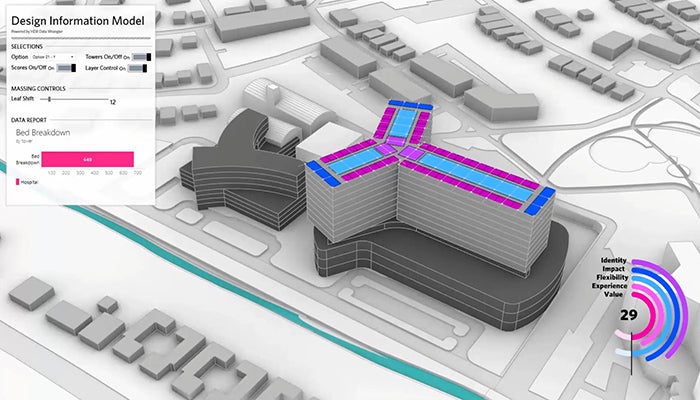Using the Data Wrangler to Design for Impact
Architecture is in the midst of radical change due to the exploration and rapid explosion of technology. New tools, new processes — especially the infusion of data — enhances the possibilities and outcomes that can be achieved in the built environment. We can now translate new and ever-growing data-sets into actionable information that allow us to design for impact.
We call this “impact-driven design” because it allows us to use evidence-based decision-making to develop design solutions that result in favourable, predictable outcomes. We’ve developed smart design software called the Data Wrangler that allows us to access robust structured data for iterative, real-time comparative design analysis.
With the Data Wrangler process, we can develop more robust early-stage conceptual models with custom metadata.
What is the Data Wrangler?
In a traditional design process, when a series of architectural design concepts are generated, the design team and the client are able to have a conversation about the unique set of qualitative and quantitative characteristics, both positive and negative, that each option embodies. In this scenario, decisions are traditionally informed by a high-level discussion of these characteristics. For example, option A may have more glass than option B, which will increase cost but will allow for better views.
But when you start including more details such as skylights, glass type, exterior shading, energy load, and life cycle, what were two or three scenarios in a traditional process grow exponentially and design decisions become challenging. With each iteration, design variables are compounded, adding complexity to the review process. While this can quickly become overwhelming, it can be immensely valuable to evaluate the concepts in more nuanced detail as this can result in significant cost-savings and better performance in the final design solution.
When we receive planning requirements from a client, we work with the client to determine which variables to compare and when. Tradeoffs are then quantified and used to create a data-driven dashboard that allows for continuous analysis as new options are generated and/or modified in real time. We use the Data Wrangler process to rapidly generate data-rich conceptual elements in real time with our clients to support test fit studies.
If we need to include properties about materials and manufacturing constraints, the Data Wrangler process allows these properties to be imported and assigned to any geometry in the model. The Data Wrangler is designed as a set of plugins to the popular design tools Rhino and Grasshopper. The software is also designed with a growing set of custom integrations so that we can easily move data among other tools including Revit, dRofus, Excel, and custom relational database servers.
Using the Data Wrangler for Conceptual Design, Schematic Design
One of the most popular ways we apply the Data Wrangler process is to more easily coordinate comparative planning scenarios in the early stages of a project. Many project requirements are undefined in conceptual design and schematic design stages and design teams need to rapidly study options to help the client determine the best path forward. Early stage models often lack the data capabilities that building information modeling offers in later stages of design. With the Data Wrangler, we can easily integrate an unlimited set of data properties to their conceptual geometry in Rhino. As we adjust the model, the Data Wrangler provides instant feedback on the effect of planning decisions on areas, cost, and occupancy.
We also use the Data Wrangler process in conjunction with analysis tools to organize and store performance data that supports discussions about environmental impact and energy use. When our team combines the tool with research-driven metrics, we can use the many data integrations to inform decisions regarding budget and operating costs, productivity, space utilization, employee engagement and satisfaction, recruitment, and retention. We’ve used this process in the conceptual design and schematic design phases of many diverse building types ranging from medical centres to scientific laboratories and commercial developments.
We’ve also applied the Data Wrangler process in workplace design. The evolution of space design shows a continuous effort for improving human outcomes through alternative design strategies. Human capital is the central core of all organizations, and any design strategy that improves human outcomes brings significant value to organizations. For workplace environments, by understanding the impact of design on human outcomes, organizations can create desirable environments for users. Such environments enable organizations to increase their profits and reduce costs through retaining their best employees, minimizing turnovers, lowering absenteeism rates, decreasing health-related costs, increasing productivity and improving product/output quality.

Case Studies in Master Planning, Test Fit Studies, and Cost Estimating
Here are a few examples of ways we’ve used the Data Wrangler in recent projects:
Master Planning
On a recent master planning project with an Australian University in Sydney, we used the Data Wrangler process to assist the institution in understanding where it could locate a new building. Various data was collected and pushed into the Data Wrangler including location of staff, collaboration hotspots, department grant funding and faculty with publications. Data Wrangler process allowed the client to visualize these metrics and identify adjacencies to indicate which individuals or departments should be located nearest to each other and to pinpoint potential locations where a new building or department could spark innovation and collaboration.
Test Fit Studies
We can use the Data Wrangler process as the framework to understand and optimize an organization's global portfolio of real estate needs in implementing their workplace standards. In one instance, we began by documenting the existing condition of an organization's buildings, tracking key metrics such as area per person, usable area per building, headcount, meeting space types, conferencing ratio, and more to set the baseline for various optimization test fits developed. The test fit scenarios rapidly uncovered the potential of each site with the new space standards implemented allowing the client to understand quickly where to locate departments, shuffle staff, and leverage a high performance utilization of their real estate portfolio. Through this approach, the client was able to better occupy and update their current space and save money on building a new facility in the short term. Additionally, through occupying already built space, they were able to leave a more sustainable footprint by leveraging existing building capital.

Cost Estimating
On a separate project for the University of Pennsylvania, we used the Data Wrangler to track detailed cost data early on in design development. Because traditional cost estimations occur behind the scenes, it can be difficult for the project team and client to thoroughly understand how design decisions influence project cost. Through linking the design model to the cost estimating team, we were able to create a live link between design changes and cost feedback. Data Wrangler provided a critical connection in this feedback loop between the design and cost estimating, resulting in a more efficient design for the client.



